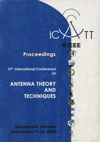Remote monitoring of sea surface HFSWR
DOI:
https://doi.org/10.1109/ICATT.2003.1238825Keywords:
HFSWR, remote monitoring, excited sea surface section, antenna arrayAbstract
The paper considers an excellent electrodynamics model of an excited sea surface when it is interpreted by spectral components of the backscattered HF signal for remotely monitored targets. A peculiarity of the application of the electrodynamics model is supposing that the excited sea surface section is a quasi-periodic random antenna array with elementary resonators.References
Skolnik, M. (ed.), Handbook on radar engineering. Moscow: Sov. radio, 1976, 456 p. (in Russian).
Kononkova, G.E. Dynamics of sea waves. Moscow: Moscow State Univ., 1969, 207 p. (in Russian).
Barrick, D.E.; Headrick, I.M.; Bogle, R.W.; Crombie, D.D. Sea backscatter at HF. Proc. IEEE, 1974, Vol. 62, No. 6, p. 673-680.
Bondarchuk, G.N.; Zarudnev, I.I.; Lupan, Y.A.; Mugenov, J.G.; Platonov, S.Y. The model of grazing HF vertically polarized radio waves back-scattering by sea surface waves. Proc. of 3rd Int. Conf. on Antenna Theory and Techniques, 8-11 Sept. 1999, Sevastopol, Ukraine. 1999, pp. 95-97, http://icatt.org.ua/proc/article/view/ICATT.1999.1236120.
Hunsen, P. Measurements of basic transmission loss for HF ground wave propagation over seawater. Radio Science, 1977, Vol. 12, No. 3, p. 397-404.
Bass, F.G.; Fuks, I.M. Wave scattering by statistically rough surface. Moscow: Nauka, 1972, 424 p. (in Russian).
Bondarenko, B.F.; Bondarchuk, G.M.; Dmytrieva, N.V.; Zarudnev, I.I; et al. Mathematical model of HFSWR. Izv. VUZ. Radioelektronika, 2002, Vol. 45, No. 1, p. 3-12.
Bondarenko, B.F.; Bondarchuk, G.M.; Dmytrieva, N.V.; Zarudnev, I.I; et al. Mathematical model of HFSWR. Izv. VUZ. Radioelektronika, 2002, Vol. 45, No. 2, p. 3-10.

